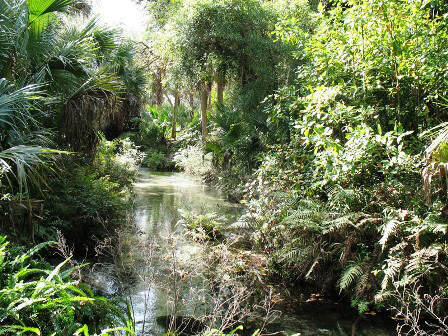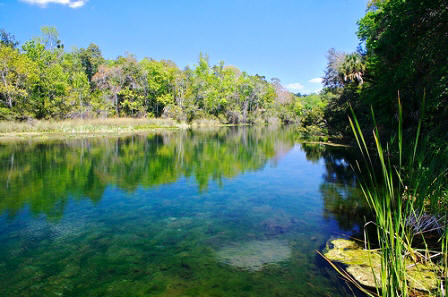Discover Florida Nature
It's time to explore the natural Florida


|
|
|
|
|
 The
Ocala National Forest is located in central Florida between the
Ocklawaha and
St. Johns Rivers. The Forest is approximately 383,000 acres and is
the southernmost forest in the continental United States. The Ocala
National Forest is rich in water resources with more than 600 lakes,
rivers, and springs. The
Ocala National Forest is located in central Florida between the
Ocklawaha and
St. Johns Rivers. The Forest is approximately 383,000 acres and is
the southernmost forest in the continental United States. The Ocala
National Forest is rich in water resources with more than 600 lakes,
rivers, and springs. Four major natural springs of crystal clear water are located in the popular recreation areas of Juniper Springs, Salt Springs, Alexander Springs and Silver Glen Springs The Forest hosts a variety of major recreation, scenic and historic areas. The recreation activities are as diverse as the environment, from canoeing in wilderness waterways, swimming in crystal clear constant 72° springs, year-round camping, picnicking, fishing, birding, hiking, bicycling, horseback riding and four-wheeling. Water plays an important part in a variety of recreational opportunities on the forest. There are huge springs, twisting streams and lakes for fishing and water skiing. Many of the scenic lakes were formed when limestone bedrock dissolved, permitting the surface layer to slump and fill with water. Snorkelers frequently find a thrilling underwater view of fish, swaying vegetation and cavernous springs. No wonder the Ocala National Forest is one of the most heavily used National Forests in the United States. The Ocala National Forest's canoeing adventures are many, as it contains approximately 600 lakes and ponds, several streams and has 2 rivers along its boundary. There is no whitewater such as you would find in the mountains, but a variety of streams awaits your visit. Each stream has its own characteristics that make it unlike any other. Some, like Alexander Spring Creek, begin broad with slow moving water and then become narrow and deep downstream. Others, like Juniper Creek, start scarcely wider than the canoe and end up more than a hundred feet wide. You won't find roads running parallel alongside the stream. You may have to duck under low hanging tree branches or lift the canoe over partly submerged logs. The streams are left in these primitive conditions to provide a challenge and a sense of achievement, and to let visitors experience the quiet beauty of the unspoiled environment.  The
Ocala National Forest contains four wilderness areas. These four areas
present a range of wilderness experiences suiting both novice and
skilled outdoor enthusiasts. While the remoteness of these swamps
provides excellent opportunities for solitude, they also offer high
probabilities of encounters with resident
bears,
alligators,
wild boars
and other denizens of the forest. Visitors are reminded not only to
practice Leave No Trace ethics while in the wilderness, but are also
cautioned to Be Bear Aware. Wilderness is a special place,
full of adventure and the unexpected; a world with few guarantees but
much to explore! The
Ocala National Forest contains four wilderness areas. These four areas
present a range of wilderness experiences suiting both novice and
skilled outdoor enthusiasts. While the remoteness of these swamps
provides excellent opportunities for solitude, they also offer high
probabilities of encounters with resident
bears,
alligators,
wild boars
and other denizens of the forest. Visitors are reminded not only to
practice Leave No Trace ethics while in the wilderness, but are also
cautioned to Be Bear Aware. Wilderness is a special place,
full of adventure and the unexpected; a world with few guarantees but
much to explore! For a truly wilderness experience, try Juniper Prairie Wilderness in the middle of the Ocala National Forest. Fans of Marjorie Kinnan Rawlings’ book “The Yearling” will enjoy hiking in the area where the 1949 movie starring Gregory Peck was filmed. Bolstered by a first-magnitude spring at the Alexander Springs Recreation Area, Alexander Springs Creek meanders through three miles of trackless, subtropical swamp before reaching Lake Dexter. The terrain is primarily subtropical hardwood swamp, interspersed with sand pine scrub, numerous small islands, and shell middens. There are no trails or old roads in its 7,941 acres, so exploring by boat is the best option. Legends has it that the pirate Billie Bowlegs hid out in Billies Bay Wilderness, from which the headwaters of Alexander Springs Creek arises. In the interior of this 3,092-acre swamp, red maple, bay, sweetgum, cabbage palms and loblolly pine filter the sunlight. A dense understory of palmetto and gallberry hides the swampy interior and discourages any attempts at bushwhacking. At 2,883 acres, Little Lake George Wilderness is the smallest of the wilderness areas on the Ocala National Forest, but it’s the only one that boasts a shoreline. Near the confluence of the St. Johns and Ocklawaha Rivers, paddling is the best way to reach this remote area. There are no old roads or trails into the area. |
|
|
Ocala National Forest Florida
The Ocala National Forest is located in central Florida between the Ocklawaha and St. Johns Rivers. The Forest is approximately 383,000 acres and is the southernmost forest in the continental United States. Water plays an important part in a variety of recreational opportunities on the forest. There are huge springs, twisting streams and lakes for fishing and water skiing.
Four major natural springs of crystal clear water are located in the popular area: Juniper Springs, Salt Springs, Alexander Springs and Silver Glen Springs. The Forest also hosts a variety of major recreation, scenic and historic areas. The recreation activities are as diverse as the environment, from canoeing in wilderness waterways, swimming in crystal clear constant 72° springs, year-round camping, picnicking, fishing, birding, hiking, bicycling, horseback riding and four-wheeling. Juniper Springs is my favorite of the bunch, with clear spring water, a large swimming hole and the opportunity for a four hour canoeing trip. If you love Floridian nature, you will love any of the many areas found in the Ocala National Forest.
Written by: Floridian Nature
Ocala National Forest
Date published: 10/23/2013
3 / 5 stars
|
|